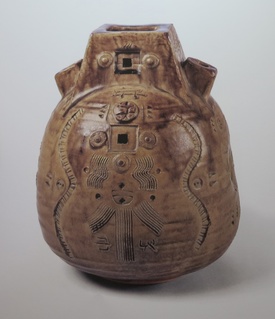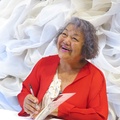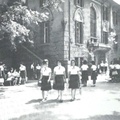After serving as a volunteer in the Japan Overseas Cooperation Volunteers, he traveled around Central and South America and ended up in Brazil
Nakatani was born on May 23, 1943 in Osaka City, Osaka Prefecture, as the fourth of five boys. He graduated from the Kyoto University of Arts (now the University of Education) Fine Arts Department and worked at the Nitten Exhibition, which handles exhibition construction at commercial facilities, but he quit after one year, disgusted by the reality that his designs were subject to change based on client orders.
He happened to see a modern ceramics exhibition at the Kyoto Museum of Modern Art, and immediately knew it was the one for him. While working at a foundry in Kyoto, he visited many ceramic studios, and was so fascinated by the ceramicist Mitsuo Kanae that he studied under him for two years. "I learned all the basics of pottery there," he recalls. He also spent a year working as an assistant at a daily utensil studio in the Koishiwara district of Fukuoka Prefecture, known as a pottery village, where he learned how to use a potter's wheel.
"I had a strong desire to get a job, leave my parents' home, and break free from all ties," so from 1971 he joined the JICA Japan Overseas Cooperation Volunteers and taught pottery in El Salvador for two years. The volunteer program was established in 1965 and continues to this day. During his vacation from school, he traveled to neighboring Central American countries, Honduras, Guatemala, Mexico, and other places, mainly visiting the ruins of ancient Mayan civilization.
"I was particularly impressed by the Tikal ruins in Guatemala. If you climb to the top of the 65-meter-tall pyramid, you can see the whole surroundings. It's a 360-degree primeval forest," he says. The impressions of the ruins and excavated tools he saw in Central America were strong, and they have had a strong influence on Nakatani's early works.
He was supposed to return to Japan after his volunteer period, but he continued to wander around Central and South America for about two years, eventually arriving in Brazil. On the way, he visited the Amano Museum in Lima, Peru, which exhibits valuable historical materials from the Andean civilization. The museum's founder, Yoshitaro Amano, was still alive at the time, and he offered him advice on making a living as a potter. "You should go to Brazil. There is a very warm-hearted community there," he recommended.
I came here as a tourist and got a permanent residence visa by throwing myself into it
A typical postwar immigrant would come with the intention of relocating from the beginning. But Nakatani was different. In 1974, Nakatani came as an extension of a trip and settled down without any relatives. Of course, he did not have a permanent residence visa.
"At that time, it was possible to switch from a tourist visa to a permanent resident visa, but you needed a place of employment to prove that you had a stable income. I went around to a few Japanese companies and asked them, but they refused because you needed a permanent resident visa just to work for them." However, once Nakatani finds something he likes, he doesn't give up easily.
By chance, he heard a rumor that SENAI (Industrial Training Service Organization) had a vacancy in the pottery class, so he went to the headquarters on Paulista Avenue and asked directly, "Can you hire me?" The person who answered the phone was a person of German descent, and even though Nakatani couldn't speak Portuguese properly at the time, he was happy to hire him because "Brazil is a country of immigrants," and even helped him apply for a permanent residence visa. He taught in Spanish that he had learned in El Salvador.
But after a year, he quit and started his own studio in San Simão, a town famous for its clay production. The first piece he made there was a typical scene of a rural Brazilian town: a church and a cross in front of it.
However, he ran into the reality that there were no big cities nearby and his work could not be sold, so he thought he had to live near the city of São Paulo and started looking for a place to live. He was told that there was a vacant house on the Maeda Farm in Ibiuna, and while he was working there for two years, he met Kunio Kitakata, an agricultural engineer at Takenaka Shokai, who sold him the land he owned in Cocuela, Mogi, on favorable terms. "He is one of the people I respect in Brazil." He moved there in 1978 and still has his studio there today.
After retiring from Takenaka Shokai, Kunio Kitakata was persuaded by Katsuya Araki, then president of the Pan-Zuttura Flower Growers Association, to move to Alger and contribute to agricultural guidance. At the Alger Flower Festival site, there is a monument bearing his haiku, "The Joy of Living in Love and Beauty: A Flower Festival."
The source of inspiration shifts from ancient civilizations to organisms

Nakatani's work initially drew inspiration from ancient civilizations in Central and South America, but was influenced by Brazil itself, which led to a shift towards more organic designs, with intricate, intricate shapes reminiscent of coral reefs or brains.
When asked why he chose this shape, he replied, "Because I wanted to pursue a form that could only be made with ceramics. I searched for a form that could maximize the potential of ceramics and glazes to capture something organic, ecological, and primitive that has been lost in modern civilized life, and this is what I came up with" (Collection of Works, p. 129).
"My mother at home repeatedly suggested that I come back to Japan and do pottery on the premises." The land of his family home was large, and there was plenty of space to set up an atelier, but Nakatani declined. "If I had lived in Japan, my work would have been completely different. I don't know how my work compares to the best Japanese pottery. But I always have the desire to compete. I think the feeling of living in Brazil is reflected in the organic design."
He held solo exhibitions in Brazil and Japan, and exhibited his work at various ceramic exhibitions. In 1980, he exhibited his work at the International Ceramics Exhibition held in Faença, Italy, one of the centers of European ceramics, and was awarded the Presidential Medal.
In 1984, he held the first ceramics exhibition at Bunkyo and became chairman of the ceramics committee, a position he held for five years. At the height of his career, he began the restoration of Casarón in 1996.
The restored Casaron de Chat (tea house)
Nakatani recalls, "When I called for the restoration of Casarón, I was told everywhere, 'What's the point of doing that?' and 'It's impossible anyway.'" The reason he decided to get involved in the Casarón restoration, which would not earn him a penny, was not because of some noble cause, such as wanting to preserve Japanese culture or because it has cultural value, but because he felt an attachment to the building and sensed the sensibility common to those who make handicrafts."
"There's a warmth to the curved tiles around the entrance, and the natural shape of the branches that are incorporated into the interior design. Carpenters and potters have something in common, both of which are handicrafts. It's not that there's any meaning to it, but rather that they pay attention to the smallest details and create something beautiful. Carpenters and potters do the same thing," he says, thinking carefully about each word. His way of speaking gives him a unique persuasiveness.
The same passion that he has for his art was poured into the restoration of Casaron. It is not a tangible work of art, but art as an "act." As I read the book, I thought that the restoration project itself was his work of art.
In 2017, Giovanna de la Gracia, a master's student at the Federal University of São Paulo, compiled Nakatani's achievements as a thesis. After reading it, Nakatani had the idea to turn it into a book. She applied to PROAC (São Paulo State Cultural Tax-Free Program) and was approved. She then looked for a sponsoring company, which led to the publication of this book.
"I started working on it in March of last year (2018) and finally finished it," said Nakatani. The book's publication party was held at Casaron last October.
Enock Sacramento, Giovana Delagracia. And Kinori Nakatani his face and his life. ( 40 reais)
*This article is reprinted from the Nikkei Shimbun (October 8, 2019).
© 2019 Masayuki Fukasawa / Nikkey Shimbun







